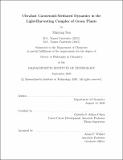| dc.contributor.advisor | Gabriela S. Schlau-Cohen. | en_US |
| dc.contributor.author | Son, Minjung,Ph. D.Massachusetts Institute of Technology. | en_US |
| dc.contributor.other | Massachusetts Institute of Technology. Department of Chemistry. | en_US |
| dc.date.accessioned | 2021-01-06T20:16:54Z | |
| dc.date.available | 2021-01-06T20:16:54Z | |
| dc.date.copyright | 2020 | en_US |
| dc.date.issued | 2020 | en_US |
| dc.identifier.uri | https://hdl.handle.net/1721.1/129294 | |
| dc.description | Thesis: Ph. D., Massachusetts Institute of Technology, Department of Chemistry, September, 2020 | en_US |
| dc.description | Cataloged from student-submitted PDF of thesis. | en_US |
| dc.description | Includes bibliographical references (pages 209-233). | en_US |
| dc.description.abstract | Photosynthetic organisms, including green plants, have mastered the ability to efficiently capture sunlight and rapidly transport the absorbed energy to drive life-sustaining chemical reactions. At the same time, they have evolved mechanisms to dynamically regulate photosynthetic efficiency to protect against photodamage in excess sunlight, by dissipating excess energy as heat. Both light harvesting and photoprotective dissipation take place within pigment-binding membrane proteins called light-harvesting complexes, and originate from the interactions of the electronic transitions of the bound pigments that span the visible solar spectrum. In particular, carotenoids, the accessory light-harvesting pigments in plants, are thought to play a central role in mediating both light-harvesting and dissipative pathways by leveraging their unique electronic structure with one or more dark states and extreme sensitivity to local environment. | en_US |
| dc.description.abstract | However, carotenoid-mediated photophysics in plants have remained poorly understood due to limited spectral bandwidths of previous ultrafast measurements as well as use of unphysiological experimental environments. In this thesis, I describe how I overcome both limitations by combining an ultra-broadband ultrafast spectroscopic technique with improved spectral bandwidth and a near-physiological model membrane to house the light-harvesting complexes with conformations close to their native ones. In Chapter 2, I describe the development of a high-sensitivity ultrabroadband two-dimensional electronic spectrometer that enables interrogation of the energetics and dynamics of the broad range of electronic transitions of photosynthetic light-harvesting complexes across the visible solar spectrum. | en_US |
| dc.description.abstract | Then, I discuss the application of this technique on studies of the light-harvesting and dissipative photophysical pathways in light-harvesting complex II (LHCII), the principal light-harvesting complex in green plants. A series of previously uncharacterized carotenoid-mediated light-harvesting and dissipative pathways are uncovered. In Chapter 3, I find that one of the four carotenoids bound within LHCII plays an integral role in mediating the rapid and efficient energy transfer in plants, partially via a previously debated but unobserved dark state. In Chapters 4-6, I discuss the direct observation of a predicted but uncharacterized dissipative energy transfer pathway involving a short-lived carotenoid dark state. The sensitivity of dissipation to local environment, carotenoid composition, and protein-protein interaction is explored within the near-physiological model membrane platform. | en_US |
| dc.description.statementofresponsibility | by Minjung Son. | en_US |
| dc.format.extent | 233 pages | en_US |
| dc.language.iso | eng | en_US |
| dc.publisher | Massachusetts Institute of Technology | en_US |
| dc.rights | MIT theses may be protected by copyright. Please reuse MIT thesis content according to the MIT Libraries Permissions Policy, which is available through the URL provided. | en_US |
| dc.rights.uri | http://dspace.mit.edu/handle/1721.1/7582 | en_US |
| dc.subject | Chemistry. | en_US |
| dc.title | Ultrafast carotenoid-mediated dynamics in the light-harvesting complex of green plants | en_US |
| dc.type | Thesis | en_US |
| dc.description.degree | Ph. D. | en_US |
| dc.contributor.department | Massachusetts Institute of Technology. Department of Chemistry | en_US |
| dc.identifier.oclc | 1227703791 | en_US |
| dc.description.collection | Ph.D. Massachusetts Institute of Technology, Department of Chemistry | en_US |
| dspace.imported | 2021-01-06T20:16:53Z | en_US |
| mit.thesis.degree | Doctoral | en_US |
| mit.thesis.department | Chem | en_US |
